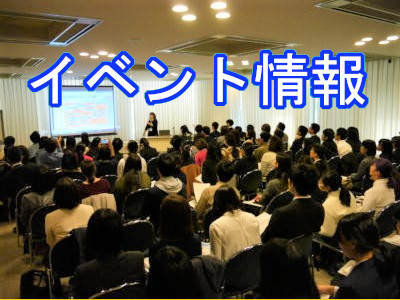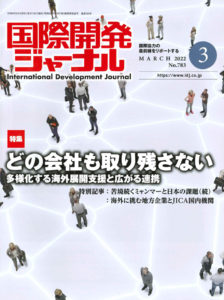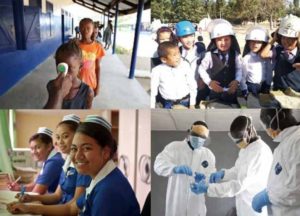IDJ-ENGLISH Response by Development Consultants to Paradigm Shift: Away from 20th Century Development Model
Response by Development Consultants to Paradigm Shift: Away from 20th Century Development Model
Dr. Hashimoto Tsuyoshi
Chief Executive Director
RECS International Inc.
-
- Paradigm Shift in Response to SDGs
Recognition of the UN SDGs and efforts to contribute to their attainment appear to have spread worldwide in the past few years. Many firms have changed their position from just tugging SDGs to company policies to reflecting their contribution to SDGs for procurement of raw materials, resource savings, reduction of CO2 emission, and other measures in their business plans. At the level of individuals, practices have been spreading to reduce the use of plastic shopping bags and to comply with separate discharge of solid wastes.
On the other hand, some point out that such practices divert people’s attention from the real crisis by giving them a sense of contributing to SDGs as remission of sins and worse, they may be even harmful in overcoming the crisis. It is also argued that to save humans from the crisis represented by climate change, the capitalism system itself needs to be changed as the root cause of the crisis (Saito, 2020).
As a development consultant involved in technical cooperation to prepare a national comprehensive development plan for Mongolia since January 2019, I have been advocating a shift in development paradigm. Mongolia has experienced a kind of paradigm shift since 1990 from the socialistic planned economy paradigm. By developing mineral resources, especially coal in large scale, Mongolia realized one of the highest economic growth rates in the world during 2000s. Obviously, such a high economic growth cannot be sustained in view of the current strong head wind in the world against coal utilization in recent years.
Therefore, I have been advocating another shift in development paradigm for Mongolia toward a sustainable development in line with the UN SDGs. However, SDGs do not tell specifically what kind of paradigm to be pursued, and there exist contradictions between some targets specified by the SDGs. The issue has been how to propose a realistic and concrete development paradigm for Mongolia to pursue in decades to come. A national comprehensive development plan has been formulated through discussions on development directions by a wide range of stakeholders at many meetings called multi-stakeholders’ meetings.
- Comparison of Two Development Models
As part of efforts to pursue a sustainable development paradigm, two development models are compared (Table 1). The 20th century development model is resource intensive and oriented to economic efficiency. This was pursued by most developed countries during the 20th century, which realized high economic growth rates at the cost of many social and environmental problems. The alternative socio-economy model is an alternative to the 20th century model.
Table 1. Comparison of Two Development Models
| 20th century development model | Alternative socio-economy model | |
| History | Pursued by most developed countries during 20th century | Sporadic attempts started recently in developing and developed countries |
| Resources | Income à Abuse | Capital à Conservation |
| Criterion | Economic efficiency | Social and environmental considerations |
| Effects | Highest income possible | Largest employment opportunities |
| Technology | Advanced technology | Appropriate or intermediate technology |
A fundamental difference between these two models is in the ways they treat resources. The 20th century development model treats resources as income. For instance, if you extract mineral resources, you will gain income almost immediately. More resources you use, higher income you gain. This tends to result in abusive use of resources. The alternative socio-economy model treats resources as capital, which should be conserved as much as possible so that it will continue to produce benefits over generations.
The 20th century development model aims primarily at economic growth, while the alternative socio-economy aims at creation of diversified employment opportunities. Employment that generates income is the basic condition for individuals to realize better life. In this connection, the so called “work-life balance” advocated by the Japanese government recently is totally wrong. “Work” is integral part of “life” according to the idea of alternative socio-economy.
- Basic Structure of Capitalism and Its Operational Issues
Based on the idea that resources represent capital, how can we understand the argument to attribute the current crisis facing human beings to capitalism? Let’s think the issue in a fundamental way.
The basic structure of capitalism is to allow many to muster capital contributions to undertake better economic activities that cannot be undertaken by any individual. With resources as capital, those who own resources, a country or an individual, can participate in better economic activities as capitalists. Outcomes of such activities are shared by all the capital contributors and allocated in proportion to their contributions. The capital accumulation is used partly for re-investment and such better activities will be continued at higher level for increased production.
In this basic structure, key issues are how to muster capital contributions, how to share and allocate outcomes according to the contributions, and how to make decisions collectively. These are issues related to social system that determines what should be produced with the capital (or determines what would be marketable on the demand side), which resources should be utilized for production on the supply side, and who would make decisions. In case of a joint-stock company, the management makes decisions in consideration of shareholders. This system leads to what is called shareholder capitalism according to neoliberalism.
Most shareholders pursue short-term profits by buying and selling shares of multiple firms. To satisfy these shareholders, the management of firms tend to pursue also short-term profits. This tends to reduce awareness of the firm as a social entity to contribute to long-term benefits for the society. In contrast, stakeholder capitalism has been advocated recently that would consider benefits for clients, employees, sub-contractors and local communities.
The prevailing capitalism is built in its structure disparities in abilities to access information and technologies necessary for resources mobilization and decision-making mechanism on how to share and allocate outcomes. This structure, therefore, aggravates disparities. This mechanism may be understood more clearly in the context of development aid to developing countries.
- Problems of Capitalism from the Viewpoint of Development Aid
Developed countries and the wealthy people have more abilities to access proper information, enjoying larger outcomes and dominating decision-making. Developing countries and the poor people have less abilities and therefore should be supported by strengthening abilities to access information and to develop and utilize technologies, ensuring a larger share of outcomes and directing re-investment more to developing countries. This should be the role of development aid.
If the total amount of outcomes is the same, however, the portion of outcomes to be provided to developing countries may be increased only by sacrificing allocation to developed countries or to the wealthy people. The portion of outcomes for re-investment would be directed more to developed countries, where investment efficiency is higher. Most important condition related to investment efficiency is ability to access broad information including availability of technologies. This is the fundamental reason why technical cooperation is most important in development aid.
Among those involved in development aid, importance of technical cooperation through education, skill training and other means is well recognized. Unlike provision of goods and money, provision of technologies to developing countries will not reduce their availability in developed countries. While developing countries develop with technologies provided by developed countries, further technological innovation will occur in developed countries to allow further economic development, which will make it possible for them to continue development aid to developing countries. Economic growth in developing countries will benefit developed countries as well. This is the ideal formula of development aid. In reality, however, developed countries make an excuse for not sacrificing their wealth in view of capital accumulation necessary for technological innovation.
The movements to demand reforms of shareholder capitalism following neoliberalism have been expanding among young generations. To create meaningful outcomes globally by mustering such grass-root movements, some fundamental changes in social system are necessary based on some ideas or value that can be shared widely. Such changes represent a paradigm shift indeed. To realize the paradigm shift, some political re-alignment would be necessary, which would link grass-root movements by common value (Asuka, 2021).
- Lessons from COVID-19: Directions of Paradigm Shift
COVID-19 provides a trigger for changes in various aspects including possibly a paradigm shift as well. One important lesson learned from COVID-19 is wide recognition of essential workers. Not only medical and care taking personnel and those involved in management and maintenance of lifeline infrastructure, farmers producing food products and those responsible for supplying basic goods such as clothing and housing are also essential workers. They contribute collectively to creating “social goods” or “common” in the form of pleasant living environment.
It is now well recognized that these essential workers are only modestly compensated for their services as compared to their contributions to the society. It constitutes important part of the paradigm shift to change the social system so that they would be compensated proportionally to their contributions. For instance, farmers may contribute their farmland as capital according to the idea of resources as capital and participate in a shareholding company to undertake processing and marketing of agricultural products and gain good portions of company’s profits. To realize this idea, legal and institutional arrangements would have to be changed related to land ownership, use and transaction. This is one specific aspect of the paradigm shift.
Capital yields benefits as it is utilized. Obtaining benefits without utilizing capital is rent seeking. Establishment of social system to prevent land rent seeking is part of the paradigm shift. Such changes as illustrated can be realized even under capitalism by just changing social systems. Processing and marketing of agricultural products by a shareholding company with farmers as shareholders are actually undertaken today by some agricultural cooperatives. Practices of production and consumption through cooperatives are consistent with the claim by young generations that capitalism should be converted to participatory socialism.
A paradigm shift means changing social value systems, which is nothing new. How to call them collectively may be only a secondary concern, but how it should be called is an important consideration for the changes to be widely accepted in the society. Young generations such as the millennium generation or Z generation may prefer using participatory socialism to express objection to capitalism. The elderly may have a sense of resistance against the term “socialism.” The paradigm shift in response to climate change may cause conflicts between different generations. The paradigm shift may be realized only through an alteration of generations if not armed conflicts between generations. As far as climate change is concerned, however, time is a big factor. We cannot wait for the alteration of generations to overcome the crisis by climate change.
The paradigm shift will have to be realized substantively in the next decade or so. For this, it is not sufficient just to expect developed countries and the wealthy to lower their life standards voluntarily to delay the occurrence of the crisis. Also, it is not sufficient to expect optimistically that technological innovation supported by capital accumulation will save the human beings from the crisis. Developing countries should not follow in footsteps of developed countries that pursued the 20th century development model. Rather, it is developing countries that should present a new development paradigm that may be followed by developed countries. This is what I have been thinking as a development consultant.
- Efforts by Development Consultants for Paradigm Shift
As a development consultant, I have been trying to reflect the paradigm shift for sustainable development in development aid, while deepening the idea of alternative socio-economy as I taught at Gakushuin University, the Economic Department, during 2001-16 (Hashimoto, 2018). Specifically, I practiced technical cooperation for development planning in the Southeast Myanmar region, Bangsamoro region in Mindanao, the Philippines and the Mongolia national comprehensive development plan among others. In Myanmar, some expressed concern that the alternative socio-economy might sacrifice economic growth. To conciliate them, the development plan was prepared as a compromise between the two development models.
In Bangsamoro, the idea of alternative socio-economy was relatively readily accepted by the Moro Islamic Liberation Front (MILF) which pursues an asymmetric development drawing a line from the mainstream Philippine economy. This helped for MILF to establish ownership for the development plan. Unfortunately, however, the plan has not been much utilized yet as enactment of the Bangsamoro basic law was delayed.
As mentioned above, the technical cooperation to prepare a national comprehensive development plan of Mongolia started after Mongolia realized high economic growth by development of coal and other mining resources following the 20th century development model. The technical cooperation proceeded to prepare a Mongolian model of alternative socio-economy, while the Mongolian Government was still pursuing large scale mining and mega infrastructure-driven development.
As an example of economic activities in line with alternative socio-economy, livestock industrial cluster development is strongly recommended under the strategy for industrial cluster promotion based on primary production. This industrial cluster will utilize not only meat and dairy products and hides and skins for leather products, but also intestines, blood and bone meal, placenta and others without wastes to produce various products including some high value-added products for export. To support the industrial cluster development, transport and communications infrastructure is planned to link grazing land, primary and value-added processing sites, and urban and export markets, while strengthening urban functions as well. Possibilities of e-transaction for various livestock products in the global market are also suggested.
Despite the strong headwind against the coal use worldwide, the Mongolian economy needs coal export for foreign exchange earnings and coal fired thermal power generation to reduce dependency on imported electricity for some time. I called attention that large scale coal fired thermal power plants would become stranded assets sooner or later, and the NCDP proposes the establishment of a clean energy center to improve the quality of low-grade coal and lignite and regional energy supply systems based on renewable local energy sources including geothermal, solar, wind and hydropower rather than large scale thermal power plants linked to the national power transmission lines.
The Mongolian Government may be still pursuing mega project driven development. The concept of alternative socio-economy, however, has been accepted by many including youth groups through multi-stakeholders’ meetings. At least the term has been well understood in the Mongolian society.
The Engineering and Consulting Firms Association (ECFA) of Japan prepared its vision for 2030, where contribution to SDGs is declared as one of objectives. In preparing the vision, I encouraged the director in charge that SDGs represent survival strategy for human beings and development consultants are essential workers to save human beings from the crisis. Although the paradigm shift is difficult to achieve as it involves political re-alignment, we have no option but to continue our daily efforts by raising awareness.
REFERENCES
Asuka, Jusen, “New Green Deal,” (in Japanese), Iwanami publishing co., June 2021.
Hashimoto, Tsuyoshi, “Last Lecture by Part-time Lecturer of Economic Department,” (in Japanese), International Development Journal, April, 2018.
Saito, Kouhei, “Capitalism in Anthropocene,” (in Japanese), Shueisha publishing co., September 2020.
*****以下、日本語原文*****
開発コンサルタントによるパラダイム転換への対応
“20世紀型の後追い”からの脱却を
(株)レックスインターナショナル代表取締役
橋本 強司
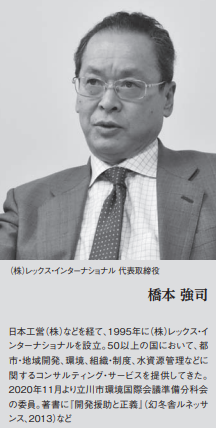
昨今、ポスト/ウィズ・コロナ時代を見据え、資本主義の再考など新たな開発パラダイムを探る議論が活発だ。岸田文雄新首相も「新しい資本主義」の実現を経済政策の柱に据えた。こうしたパラダイム転換の波に、開発コンサルタントはどう対応していくべきか。アジア諸国などの開発計画策定を支援してきた本誌論説委員の橋本強司氏が、現在携わるモンゴルの事例を取り上げつつ論考する。
SDGsに即した転換を提唱
国連による持続可能な開発目標(SDGs)に対する認識と達成に向けての努力が、ようやく広がってきたように見える。企業においては、SDGsを新しい事業方針のタグ付けに利用する段階から、原材料の調達先の賢い選定、資源の節約や二酸化炭素(CO₂)排出の削減などを事業計画に組み込む努力がされるようになってきたようだ。個人においては、レジ袋削減や家庭ごみの分別排出などの実践が広がっている。
一方で、SDGsのために「何かをやっている意識」は、「免罪符」となって危機から目を背けさせるだけでなく、気候変動への効果は乏しく「有害」ですらあると指摘する向きもある。気候変動に代表される危機から人類を救うには、その根本原因としての資本主義の仕組みを変える必要がある、との論もある(斎藤幸平、2020年)。つまりはパラダイム転換が必要ということである。
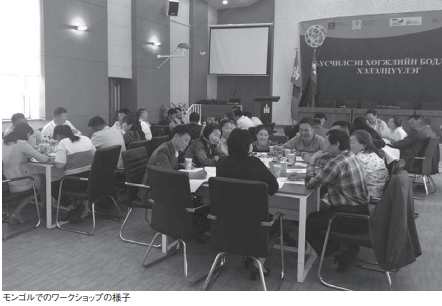
私は2019年1月より携わってきた、モンゴルにおける国家総合開発計画策定支援の技術協力の中で、開発パラダイムの転換を提唱している。モンゴルは1990年以降、それまでの社会主義的計画経済による開発から一種のパラダイム転換を経験した。鉱物資源、特に石炭の大規模開発によって2000年代には世界有数の高い経済成長率を達成した。しかしこのような開発が持続できないことは、最近の石炭に対する国際的な強い逆風だけを考えても明らかである。
そこで現在、同国に対して国連SDGsに即した持続可能な開発へのパラダイム転換を提唱している。しかし、実のところSDGsはいかなる開発パラダイムを追求すべきかについては何も具体的に語っておらず、多くの目標間には相互に矛盾も少なくない。このため、いかに現実的で具体的な開発パラダイムを提示するかが課題であった。さまざまなステークホルダーとマルチステークホルダー(MSH)会合を重ねて、開発の方向性を探りつつ開発計画を策定してきた。
二つの開発モデルの比較
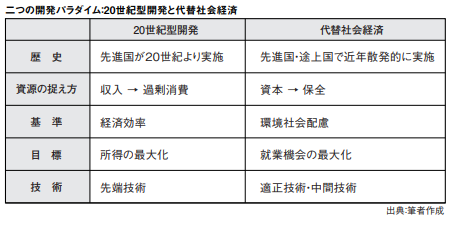
そのような開発パラダイムを模索する一環として、二つの開発パラダイムを比較説明している(表を参照)。「20世紀型開発モデル」は、資源集約型で経済効率志向である。これは20世紀を通じて先進国が志向してきたもので、高い経済成長率を達成したが、環境社会面に多くの問題が生じた。これに対して「代替社会経済モデル」を提示している。
これら二つのモデルの本質的違いは、資源に対する見方にある。20世紀型開発は資源を「所得」と捉える。鉱物資源などの地下資源を考えると分かり易い。資源を掘り出すと即、所得に結び付く。資源を使えば使うほど所得は増える。結果として資源の過剰消費につながる。代替社会経済は、資源を「資本」と捉える。資本は極力保全する必要があり、それによって世代を超えて便益を生み出し続けることが可能となる。
また、20世紀型開発は経済成長を一義的に目指す。代替社会経済は多様な雇用を創出することを目指す。言うまでもなく、雇用は所得によって個人がよりよい生活を実現するための基本条件である。ついでながら日本政府が最近強調している「ワーク・ライフバランス」の二分法は、認識が根本的に誤っている。「ワーク」は「ライフ」の不可分の一部であり、これは代替社会経済の考え方でもある。
資本主義の基本構造と課題
さて、資源=資本という考え方に立つと、人類の危機を資本主義に帰する考えは、どう理解したらよいのだろうか。本質に立ち返って考えたい。資本主義の基本は、多くの人が資本を糾合し、一人ではできないよりよい経済活動をすることだと考える。その上で資源=資本と捉えると、資源を所有する人(国)も“資本家”として資本を糾合し、よりよい経済活動を行う仕組みに参加できることになる。活動の成果は資本蓄積も含めて資本提供者間で共有し配分する。
その一部は再投資に向けられ、よりよい活動や生産が拡大・継続する。
つまり資本主義では、資本の糾合の仕方、それに見合った成果の共有と配分の仕方、そのための意思決定の仕方が重要となる。これは社会の仕組みの問題であり、資本を糾合して何を作ったらよいか(何が売れるか)、そのためにどの資源が必要か、これを判断し決めるのが仕組みである。株式会社という仕組みの場合は、もちろん経営者が決めているのであるが、決定において株主に配慮する必要がある。この仕組みは、新自由主義経済の考えによる「株主資本主義」につながる。株主の多くは複数の企業の株を売り買いして短期の利益を求める。このような株主に配慮することは企業の短期利益志向を助長し、社会的存在として長期的便益に寄与する役割に対する意識を低下させる。これに対して最近では、株主に加えて、企業の顧客をはじめとする従業員、下請企業、地域社会に利益をもたらす「ステークホルダー資本主義」が提唱されている。
資本を糾合して社会にとって良いものを作るという資本主義の原型としての仕組みには、何を作るか、どの資源を動員するか、についての情報力・技術力の格差および成果の共有と配分についての意思決定の仕組みが埋め込まれている。だが、それが実は格差を生んでいる。この原型は、開発途上国への開発援助に当てはめると分かりやすい。
開発援助から見た問題点
より大きな情報力を持ち、より大きな成果を享受し、再投資の意思決定により大きく関っているのは、先進国であり特に富裕層である。途上国に対して情報力・技術力を強化し、成果をより多く提供し、再投資を途上国に向けるのが開発援助である。しかし共有すべき成果が一定であるならば、先進国(富裕層)の分け前を減らさなければ、途上国に提供される成果は増えない。成果の一部である再投資は、投資効率の良い先進国に向けられるからだ。投資効率に係る最も重要な条件は広い意味での情報力であり、これには技術力が含まれる。開発援助において技術協力が重要である本質的理由はここにある。
開発援助に携わる者の間では、教育や技能訓練などの技術協力の重要性はよく認識されている。モノやカネの供与と異なり、技術は供与することによって先進国側の分け前は減らない。供与した技術によって途上国が発展する間、先進国ではさらなる技術革新が起こって、それが高い水準での経済活動継続を可能とし、先進国にとっての便益も拡大し、途上国へのさらなる支援も可能となる。そして途上国の発展は先進国にも利益をもたらす。これが理想形である。しかし現実には、技術革新のために資本集積が必要という口実が、先進国が豊かさを犠牲にするのを抑制している。
若者を中心として、新自由主義経済の考えによる株主資本主義の改革を求める運動が拡大している。
そのような草の根活動を糾合してグローバルな成果に結び付けるには、共有できる理念に基づく社会の仕組みに係る何らかの本質的な変化が必要である。これこそがパラダイム転換であり、その実現のためには草の根活動を共通の価値観によって結びつける「政治 的 編 成 ( p o l i t i c a l alignment)」が必要である(明日香壽川、2021年)。
コロナ禍の教訓
コロナ禍はさまざまな変化のきっかけとなっており、パラダイム転換の切っ掛けともなり得る。一つの教訓は、エッセンシャルワーカーに対する認識である。医療従事者や介護関係者、ライフラインインフラを維持管理する人たちだけではなく、食糧生産に係る農業従事者日用品や衣料・住居の供給を支える人たちもエッセンシャルワーカーである。これらの人々は快適な生活環境という「ソーシャルグッズ」あるいは「コモン」の創出に貢献している
これらエッセンシャルワーカーについては、社会への貢献に比べて報酬が低いという共通の問題が指摘されている。報酬を貢献に見合うようにすることは、パラダイム転換の重要な側面である。例えば資源=資本という代替社会経済の考えに沿って、農業従事者が自ら所有する農地という資源を資本として提供し、会社組織を作り、農産品の加工・販売をしてはどうだろうか。これを実現する上では、土地所有や土地利用・取引に係る法制を整備する必要があり、これはパラダイム転換の一つの具体的意味である。
資本は活用することによって便益を生み出す。資本を使わずに便益を得ることは、レント・シーキング(企業が超過利潤(レント)を得るために政府官庁へ働き掛けて政策などを変更させること)であり、土地のレント・シーキングを防ぐ仕組みの構築もパラダイム転換の一環である。
以上で例示したような転換は、資本主義の下で社会の仕組みを変えることによって実現し得る。農業従事者の会社組織による農産品の加工・販売は、少なくとも形の上では現在でも農業協同組合によって実施されている。協同組合による生産や消費は、資本主義を「参加型社会主義」に転換すべきとの主張と軌を一にしている。
パラダイム転換とは社会の仕組みを変えることであり、それを総体としてどう呼ぶかは二義的なことであるが、どう呼ぶことが社会により広く受け入れられるかには配慮が必要である。最近の若い世代、Z世代とかミレニアル世代と呼ばれる人たちの多くは、資本主義に反対し、参加型社会主義という呼称を使う傾向のようであるが、年配者には社会主義という用語に抵抗があるものも多い。気候変動を契機とするパラダイム転換は世代間の対立を生む可能性があり、武力抗争にはならないとしても実現には世代交代を待つ必要があるかもしれない。しかし気候変動に関しては、それでは間に合わないのである。
今後10年程度の間にパラダイム転換が実質的に進む必要がある。そのためには先進国(富裕層)が自主的に生活水準を下げることを期待するだけでは済まない。また資本集積に支えられた技術革新が危機を救うという楽観論では済まない。途上国が先進国の20世紀型開発を後追いするのではなく、新しい開発パラダイムを提示することが効果的だろう。これが開発コンサルタントとして私が考えてきたことである。
開発コンサルタントとしての努力
私は10数年前より学習院大学経済学部で非常勤講師をしながら、考えを深め展開しつつ開発パラダイム転換を途上国の開発協力に反映しようとしてきた。具体的にはミャンマーの南東部地域、フィリピンのミンダナオ島バンサモロ地域、およびモンゴル全国総合開発計画において、代替社会経済の考えを反映する開発計画策定の技術協力を実践してきた。ミャンマー南東部では、代替社会経済は経済成長を犠牲にするのではないかとの疑問が提示され、経済成長志向との折衷的開発計画となった。
バンサモロ地域では、フィリピン主流経済とは一線を画す志向を持つモロ・イスラム解放戦線(MILF)にとって、代替社会経済の考えは受け入れられやすく、開発計画に対するオーナーシップの確立にも寄与したと思う。しかし残念ながら、バンサモロ基本法の成立が遅れたこともあって、せっかく策定された開発計画はあまり活用されていないようである。
モンゴルでは先述の通り、石炭をはじめとする資源開発による20世紀型開発が高い経済成長率を実現した直後、国家総合開発計画策定の技術協力が開始された。モンゴル政府主導による大規模鉱山開発およびそのためのメガプロジェクト志向が依然強く残っている中で、代替社会経済のモンゴルモデルを提示すべく技術協力を進めてきた。
一例として産業クラスター推進戦略の下で、畜産産業クラスターを強く提示している。食肉や乳製品、皮革製品に留まらず内臓・骨血粉・胎盤(プラセンタ)などを廃棄物にすることなく利用して、一部高付加価値製品を輸出することができる。遊牧地と加工基地、都市市場および輸出拠点を結ぶ運輸インフラ整備と都市機能の強化を計画している。さらに畜産品の電子取引によって、輸出品を世界中とオンライン取引をする方向性も示している。
石炭に対する世界的な逆風にもかかわらず、モンゴル経済は当面石炭の輸出および石炭火力による輸入電力依存脱却が課題である。これに対して大規模石炭火力は、早 晩 「 座 礁 資 産 ( s t r a n d e d asset)」となると注意喚起する一方、低品位石炭や褐炭の品質改良のためのクリーンエネルギーセンターに加えて、大規模石炭火力と全国送電網ではなく、地熱を含む再生可能エネルギーによる地域エネルギー供給を目指す提案をしている。
モンゴル政府は依然、メガプロジェクト志向の開発を目指している趣がある。一方、代替社会経済の考えはMSH会合を重ねることによって、若者グループを中心としてある程度理解されるようになっており、パラダイム転換は少なくとも用語としては定着している。
開発コンサルタントの協会である(一社)海外コンサルタンツ協会(ECFA)は、最近、2030年をめどとするビジョンを発表した。ビジョン作成に係る理事に対して私は、「SDGsは人類のサバイバル戦略である。人類を存亡の危機から救うエッセンシャルワーカーが開発コンサルタントである」と発破をかけた。政治的編成を伴うパラダイム転換は容易ではないが、開発コンサルタントとしての意識を高め日々の努力を続けるしかない。
『国際開発ジャーナル』2021年12月号掲載



